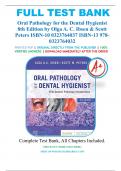Exam (elaborations)
Test Bank for Oral Pathology for the Dental Hygienist 8th Edition by Olga A. C. Ibsen & Scott Peters
- Course
- Institution
- Book
Test Bank for Oral Pathology for the Dental Hygienist 8th Edition by Olga A. C. Ibsen & Scott Peters
[Show more]



